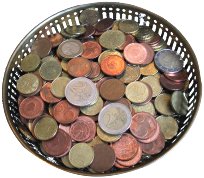So I love to adapt it. It's never quite as good as the original, but often the great structure of the original allows new features to come to light. Here's a previous handout that has the original Product Game and and Integer variation.
The fifth grade class I'm working with is beginning multiplication of decimals, by considering whole number times decimals that include tenths. They're starting the whole counting up the decimal places routine, without much though of unitization. If you have 5 bags with 4 apples each, you've got 20 apples. If you have 5 groups with 4 tenths each, you've got 20 tenths... it's just that we don't often look at 2-point-OH as 20 tenths. With my class I'd be looking for a context to start at this - probably money.
This class expects games from me, though. I thought we had played the product game already (that was last year, Mr. Golden!) - oops. In this version of the game, there's markers to make for your team. I didn't have my usual two color counters available, but I've also learned that making markers or game pieces is a point of engagement and pride for some of the students. Others are content with a quickly scrawled initial, and that's okay, too. Mr. Schiller set a time limit of 3 minutes for making your markers, which was a good idea and the right amount of time.
We were to start by playing me vs. the class, so I could model some of the multiplying strategies I wanted to share. But my son made me some excellent University of Michigan and Michigan State markers, and, being a proud alum, I had to be State. There were students who couldn't bring themselves to being on U of M's team, and how could I argue? So we played Spartans vs. Wolverines.
Product Game Decimal
The group play got us through all the rules and allowed us to model a lot of the whole x tenths. But we never got up to the hundredths. So we discussed how to get those. I think they knew on some level it was tenths times tenths, but had a bit of the 'we haven't been taught this yet' syndrome. I used the analogy of a dime being a tenth of a dollar, so what's a tenth of a dime? "A penny!" And what part of a dollar is a penny? How many does it take to make one dollar? It is terrific that they are used to seeing one cent written as .01
It was interesting seeing them play. They started out almost entirely in whole x whole, and then were forced to the whole x tenths by the game play. And if the game went on long enough, to the hundredths. Several people got calculators to explore this, and a couple got to the calculators and then beyond them in the space of the hour. Some students were done with the game after one session, but others were definitely up for more. Hope you get a chance to try it and get a little bit addicted.
Photo credits: From Flickr, jeff_golden, 24oranges.nl and fireflythegreat.



No comments:
Post a Comment